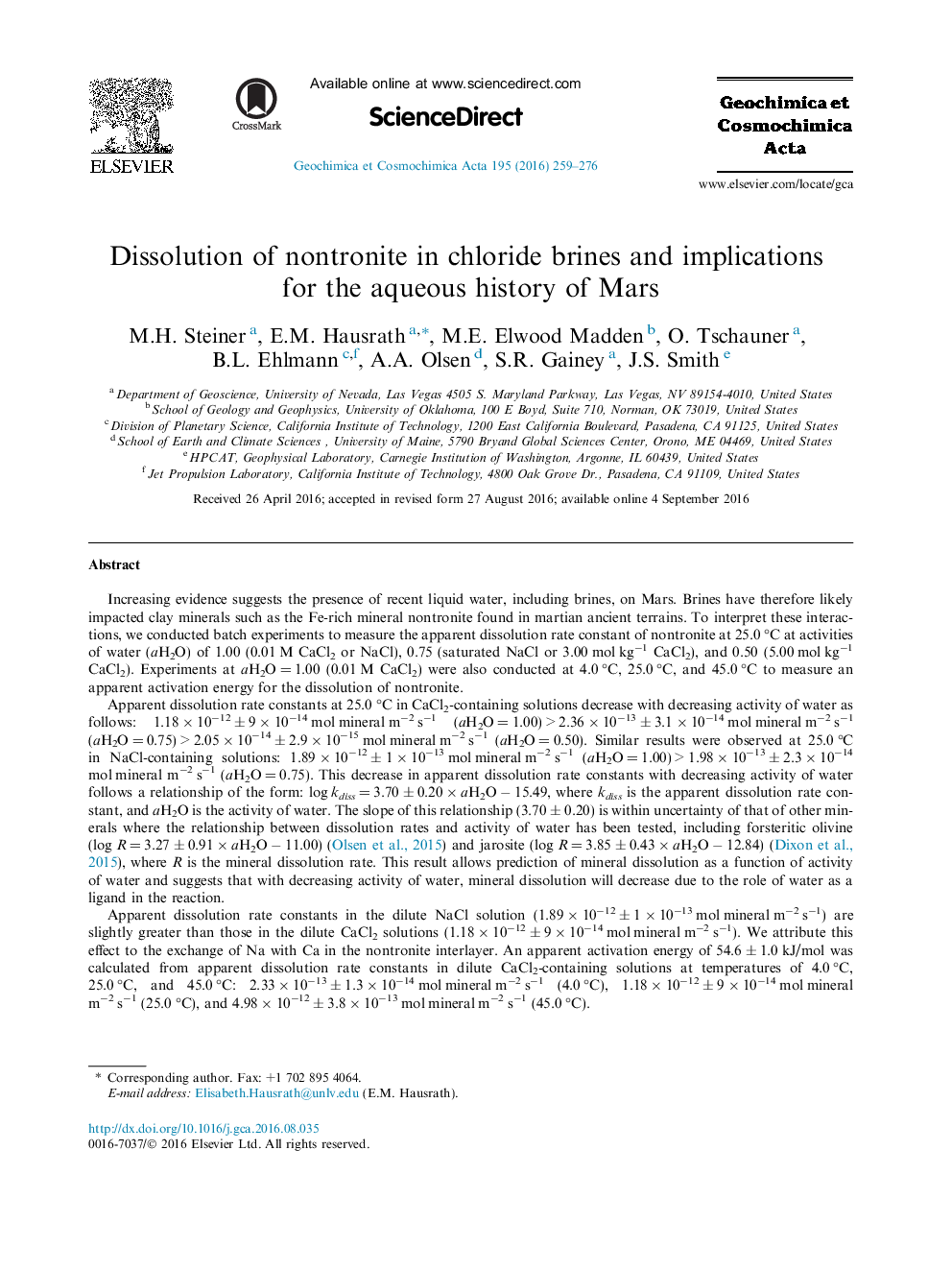| کد مقاله | کد نشریه | سال انتشار | مقاله انگلیسی | نسخه تمام متن |
|---|---|---|---|---|
| 6437078 | 1637962 | 2016 | 18 صفحه PDF | دانلود رایگان |

Increasing evidence suggests the presence of recent liquid water, including brines, on Mars. Brines have therefore likely impacted clay minerals such as the Fe-rich mineral nontronite found in martian ancient terrains. To interpret these interactions, we conducted batch experiments to measure the apparent dissolution rate constant of nontronite at 25.0 °C at activities of water (aH2O) of 1.00 (0.01 M CaCl2 or NaCl), 0.75 (saturated NaCl or 3.00 mol kgâ1 CaCl2), and 0.50 (5.00 mol kgâ1 CaCl2). Experiments at aH2O = 1.00 (0.01 M CaCl2) were also conducted at 4.0 °C, 25.0 °C, and 45.0 °C to measure an apparent activation energy for the dissolution of nontronite.Apparent dissolution rate constants at 25.0 °C in CaCl2-containing solutions decrease with decreasing activity of water as follows: 1.18 Ã 10â12 ± 9 Ã 10â14 mol mineral mâ2 sâ1 (aH2O = 1.00) > 2.36 Ã 10â13 ± 3.1 Ã 10â14 mol mineral mâ2 sâ1 (aH2O = 0.75) > 2.05 Ã 10â14 ± 2.9 Ã 10â15 mol mineral mâ2 sâ1 (aH2O = 0.50). Similar results were observed at 25.0 °C in NaCl-containing solutions: 1.89 Ã 10â12 ± 1 Ã 10â13 mol mineral mâ2 sâ1 (aH2O = 1.00) > 1.98 Ã 10â13 ± 2.3 Ã 10â14 mol mineral mâ2 sâ1 (aH2O = 0.75). This decrease in apparent dissolution rate constants with decreasing activity of water follows a relationship of the form: log kdiss = 3.70 ± 0.20 Ã aH2O â 15.49, where kdiss is the apparent dissolution rate constant, and aH2O is the activity of water. The slope of this relationship (3.70 ± 0.20) is within uncertainty of that of other minerals where the relationship between dissolution rates and activity of water has been tested, including forsteritic olivine (log R = 3.27 ± 0.91 Ã aH2O â 11.00) (Olsen et al., 2015) and jarosite (log R = 3.85 ± 0.43 Ã aH2O â 12.84) (Dixon et al., 2015), where R is the mineral dissolution rate. This result allows prediction of mineral dissolution as a function of activity of water and suggests that with decreasing activity of water, mineral dissolution will decrease due to the role of water as a ligand in the reaction.Apparent dissolution rate constants in the dilute NaCl solution (1.89 Ã 10â12 ± 1 Ã 10â13 mol mineral mâ2 sâ1) are slightly greater than those in the dilute CaCl2 solutions (1.18 Ã 10â12 ± 9 Ã 10â14 mol mineral mâ2 sâ1). We attribute this effect to the exchange of Na with Ca in the nontronite interlayer. An apparent activation energy of 54.6 ± 1.0 kJ/mol was calculated from apparent dissolution rate constants in dilute CaCl2-containing solutions at temperatures of 4.0 °C, 25.0 °C, and 45.0 °C: 2.33 Ã 10â13 ± 1.3 Ã 10â14 mol mineral mâ2 sâ1 (4.0 °C), 1.18 Ã 10â12 ± 9 Ã 10â14 mol mineral mâ2 sâ1 (25.0 °C), and 4.98 Ã 10â12 ± 3.8 Ã 10â13 mol mineral mâ2 sâ1 (45.0 °C).The greatly decreased dissolution of nontronite in brines and at low temperatures suggests that any martian nontronite found to be perceptibly weathered may have experienced very long periods of water-rock interaction with brines at the low temperatures prevalent on Mars, with important implications for the paleoclimate and long-term potential habitability of Mars.
Journal: Geochimica et Cosmochimica Acta - Volume 195, 15 December 2016, Pages 259-276